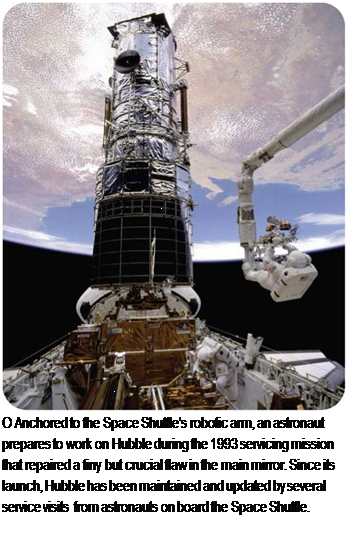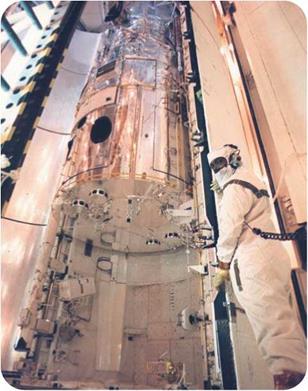Hubble in Space
Hubble’s precision optics make the most of its unique location beyond Earth’s atmosphere. The atmosphere, the blanket of gases that makes life possible on our
|
О A few days before being launched into space in 1990, the Hubble Space Telescope was carefully loaded into the payload (cargo) bay of the Space Shuttle Discovery. |
planet, is a hindrance to astronomy. By orbiting in space, above the gases, Hubble gets a much clearer view of the universe. Hubble also can be aimed very accurately to study a specific target, such as a star billions of miles away.
Right after its launch, engineers discovered there was something wrong with the telescope. There was a flaw in the optics of the main (primary) mirror. As a result of the flaw, the images Hubble received were not as clear as scientists had hoped. The cause of the problem was that the primary mirror had been ground to the wrong shape, in spite
 of the care that had been taken to make it accurate. It was too flat at the edges by a microscopic amount, but this was enough to produce what scientists called “severe spherical aberration.” Light reflecting from the edge of the mirror was focused on a different point than the light reflecting off its center, so the picture was blurred.
of the care that had been taken to make it accurate. It was too flat at the edges by a microscopic amount, but this was enough to produce what scientists called “severe spherical aberration.” Light reflecting from the edge of the mirror was focused on a different point than the light reflecting off its center, so the picture was blurred.
A Space Shuttle flight in 1993 solved this problem. Astronauts fitted a com
plex pack of five pairs of smaller mirrors to correct the aberration in the main mirror. It was like fitting a new lens in a person’s eyeglasses to sharpen his or her eyesight. It worked, and Hubble started to send back to Earth astounding images of the distant universe. In 1994, the space telescope was able to send back sharp images of Jupiter during the planet’s collision with a comet named Shoemaker-Levy 9, an event that happens only once every few hundred years.











